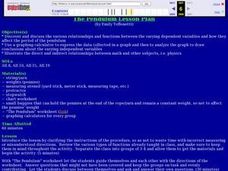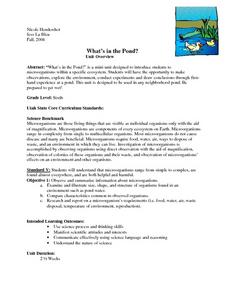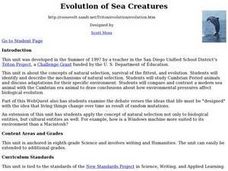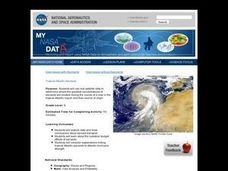Curated OER
Othello
Students examine patterns of imagery in Othello by using online resources. Students compare the patterns they see to those they've found in other Shakespeare plays. Then students draw conclusions about why Shakespeare might have used the...
Curated OER
Merchant of Venice
Students examine patterns of imagery in Merchant of Venice by using online resources. Students compare the patterns they see to those they've found in other Shakespeare plays. Then students draw conclusions about why Shakespeare might...
Curated OER
Investigating the Probability
Students investigate probability using coins and dice. They collect data, graph, organize and interpret data. They predict, describe, compare, compute and draw conclusions based on what they observe and record.
Curated OER
Behind the Movie Chicago
Learners explore the genre of the musical film and its history. They draw conclusions on relationships between a stage musical and a musical film. They share the results of their research as a class.
Curated OER
The Little Ice Age - Understanding Climate and Climate Change
Fourth graders receive data about tree ring records, solar activity, and volcanic eruptions during the Little Ice Age (1350-1850). From this data, they draw conclusions about possible natural causes of climate change
Curated OER
Pyramid of Biomass
Students interpret data to demonstrate biomass and number pyramids. They use information to draw conclusions and examine an example of biological magnification.
Curated OER
Science Lab Skills
Learners develop problem solving, decision-making and inquiry skills by planning experiments. They conduct systematic observations, interpret and analyze data and draw conclusions then communicate their results.
Curated OER
Peat Pots
Students place a peat pot in water to observe and calculate the rate of capillarity in a model of a soil. This task assesses students' abilities to make simple observations, collect, record, and represent data, use a data table to...
Curated OER
The Pendulum
Students discover and discuss relationships and functions between varying dependent variables and how they affect the period of the pendulum. They use graphing calculator to express the data collected in a graph, to analyze the graph,...
Curated OER
Sustainable Agriculture
Students explore examples of methods utilized in traditional agricultural practices. They state examples ot methods used in sustainable agricultural practices. They draw conclusions from information presented to them.
Curated OER
Focus on Friction
The students learn about friction and forces through direct instruction and an investigation. They use measurement skills, observation skills, predicting, and drawing conclusions based on data collected during the investigation. Students...
Curated OER
What's in the Pond?
Sixth graders are introduced to microorganisms within a specific ecosystem and have the opportunity to make observations, explore the environment, conduct experiments and draw conclusions through firsthand experience at a pond. They also...
Curated OER
Rotational Equilibrim: A Question of Balance
Young scholars explore the concepts of rotational equilibrium. They examine the history Alexander Calder and his mobiles. Students solve simple algebraic equations. They predict, draw conclusions, graph equations and examine the...
Curated OER
Longfellow Meets German Radical Poet Ferdinand Freiligrath
Students, after researching the backgrounds to both Longfellow and Freiligrath, examine and analyze selected works of Henry Wadsworth Longfellow via his association with the German radical Ferdinand Freiligrath. They discuss and draw...
Curated OER
There's a Place That Has a Race
Students define the term "place," collect data about Alaska and the Iditarod from several web sites, take online quiz using information gathered, and draw conclusions based upon their data collection and analysis.
Curated OER
Evolution of Sea Creatures
Young scholars identify and describe the mechanisms of natural selection. They study Cambrian Period animals and discuss adaptations for their specific environment.Students compare and contrast a modern sea animal with the Cambrian era...
Curated OER
A Helthy Diet
Pupils examine their eating habits and experience analyzing data and drawing conclusions. They construct models of the molecular backbone of saturated and unsaturated fats. In addition, they examine the labels of their food, record the...
Curated OER
Color Me Hot
Seventh graders use the scientific method, to observe, record and analyze the data they gathered. They make observations using their five senses. Students compare, contrast and draw conclusions based on the observations and data...
Curated OER
Troical Atlantic Aerosols
Students explore the effect aerosols have upon he weather and climate. They observe NASA satellite images to explore and draw conclusions about aerosol transport. From studying the images, students track the path of aerosols. They...
Curated OER
Charting and Graphing Sales
Students analyze and represent weekly sales figures using tables, bar graphs, and pie charts. They draw conclusions using bar graphs and pie charts. Students are told that each day at school they have the option of buying or bringing a...
Curated OER
Facts Of The Union
Students use internet research to fact check the 2007 State of the Union Address. They identify the major topics presented during the address and research information that supports or disclaims the statements. Students draw conclusions...
Curated OER
White House Spins Iraqi Polling
Students compare and contrast the methodology and results of two polls on Iraqis' views of the quality of life in their country. By examining the summary documents accompanying the polls, students draw conclusions about how polls are...
Curated OER
Understanding Primary Sources
Pupils draw conclusions from primary sources and share information and interpretations with a small group. They are introduced to the Jigsaw technique. Students discuss why a grocery receipt would be a primary source. They brainstorm...
Curated OER
CSI Clamshell Investigation
Pupils explore and explain how moon snails eat and where the holes in clamshells come from and then draw conclusion from the data collected. They incorporate math and graphing skills to determine if there is a relationship to a clam's...
Other popular searches
- Nonfiction Draw Conclusions
- Draw Conclusions in Reading
- Draw Conclusions Lesson
- Draw Conclusions Reading
- How to Draw Conclusions
- Infer and Draw Conclusions
- Draw Conclusions in Literacy
- Draw Conclusions in Fiction
- Fiction Draw Conclusions
- Draw Conclusions Worksheet

























